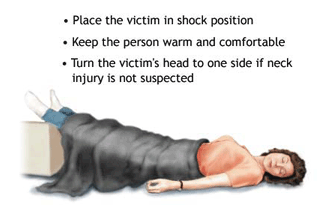First Aid – Shock
Although the term “shock” has a number of meanings, in general this refers to the failure of blood to circulate throughout the body and may result from a variety of causes.
The nervous system plays an important role in shock. The various parts of the body and the organs controlling the body functions are coordinated by the nervous system, the main parts of which are the brain and spinal cord. There are mainly two types of nerves entering and leaving the spinal cord: sensory nerves, which convey sensations such as heat, cold, pain, and touch from different parts of the body to the brain; and motor nerves, which convey impulses from the brain to the muscles causing movement.
The cardiovascular system circulates blood to all the cells in the body which delivers food and oxygen and removes waste products. This system is a complex series of vessels which can dilate and constrict depending on the signals transmitted by the nervous system. When the body is in its normal state, approximately 12 pints of blood circulate through a 150 lbs. adult, and the pumping action of the heart supplies all parts of the body to function properly. Shock is the failure of this system to provide enough circulation of blood to every part of the body.
This collapse may be caused by any of three conditions:
- blood loss
- excessive blood vessel dilation
- heart failure
Regardless of the cause of shock, the result is that there is insufficient nourishment and oxygen to all parts of the body. This causes organs to begin to die, especially the brain. As the brain weakens the victim’s power of reasoning may become decreased and he may exhibit anxiety, disorientation, confusion, and even lose consciousness.
Major Causes Of Shock are:
- severe or extensive injuries
- severe pain
- loss of blood
- severe burns
- electrical shock
- allergic reaction
- poisoning
- extreme temperature exposure
- substance abuse
Physical signs of shock may be determined by observing:
- dazed look
- excessive paleness
- nausea and vomiting
- excessive thirst
- weak, rapid pulse
- shallow, irregular breathing
- dilated pupils
While shock is a very serious condition it is reversible if recognized quickly and treated properly.

- If possible, keep the victim lying down. Elevate the lower extremities if the injury will not be aggravated. Remember that if an accident was severe enough to result in a head injury, there may be spinal damage – when in doubt, keep the victim flat.
- Make breathing and circulation easier by loosening any constricting clothing from the neck, chest, and waist.
- Minimize the victim’s movement.
- Maintain the victim’s body temperature as near-normal as possible.
- Keep the victim calm as his emotional distress may unnecessarily stimulate shock symptoms.
Anaphylactic Shock
This type of shock occurs when a person comes into contact with something they are extremely allergic to. Violent reaction may be caused from ingesting shellfish, berries, nuts, or such drugs as penicillin, or from insect stings.
The symptoms of anaphylactic shock are:
- itching, burning skin
- hives over a large area
- swelling of the tongue
- severe breathing difficulty
- tightening in the chest
- weak pulse
- convulsions
If the victim has any medication to counteract the allergy, administer it immediately and transport him to the nearest medical facility as quickly as possible.
Fainting
Fainting is a temporary loss of consciousness due to an inadequate supply of oxygen to the brain and is a mild form of shock. If a person feels faint, the initial response might be to sit down resting the head between the knees, thus easing blood flow to the brain. If the victim loses consciousness and remains unconscious for any length of time, this may be an indication of a more serious condition and arrangements for medical observation should be made immediately.